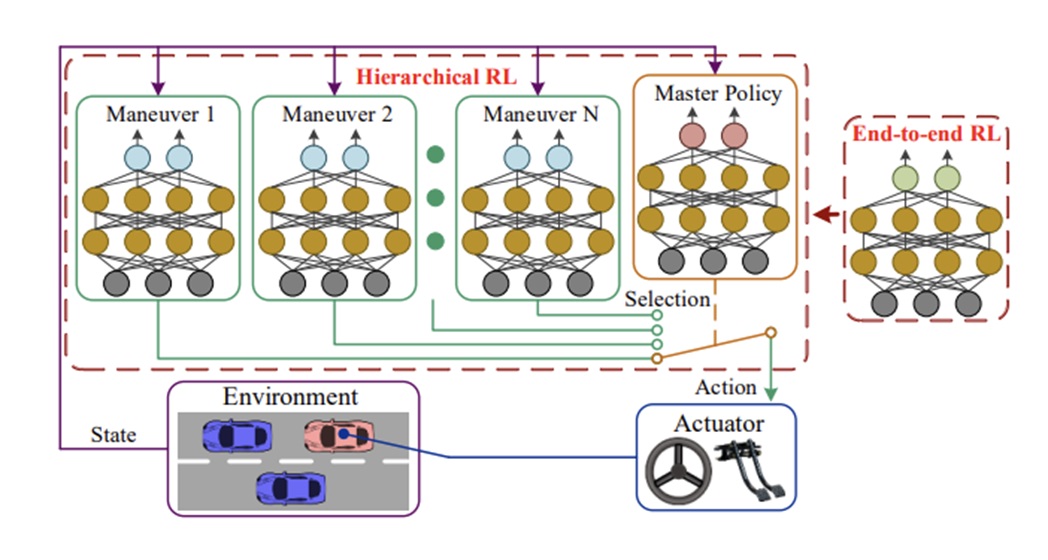Automation with Reinforcement Learning in Driving

DOI:
https://doi.org/10.54060/a2zjournals.jmss.68Keywords:
Artificial Intelligence, Machine Learning, Reinforcement Learning, Deep Reinforcement LearningAbstract
In recent years, the field of automatic driving technology has grown significantly, with the goal of driving a car without the need for human interaction. Reinforcement learning approaches have been important in this area. The application of reinforce-ment learning to automated driving techniques is examined and discussed in this work. The reinforcement learning process is where the study starts. A specific focus of the architectural framework is creating novel reward functions that promote safe and socially acceptable driving behavior while taking uncertainty factors into account with the use of sophisticated Bayesian neural networks. Understanding the scene, localization and mapping, planning and driving techniques, and control are the main topics of this work. The study also explores the particular complications connected to each of the main components of automated driving. It draws attention to how rein-forcement learning is applied in the field of autonomous driving. Autonomous vehi-cles use reinforcement learning to help them comprehend their surroundings, recog-nize roads with accuracy, drive wisely, and maintain safe control of the vehicle. The implementation and ongoing enhancement of automated driving heavily relies on reinforcement learning, particularly when combined with deep learning. Lastly, a summary and forecast covering the full study round up the publication.
Downloads
References
R. S. Sutton, & A. G. Barto, “Reinforcement Learning: An Introduction (2nd ed.)”, MIT Press, 2018.
S. Arora, “Autonomous Vehicles: A Comprehensive Guide”, Wiley, 2017.
D. Howard, M. Galea, M. Siegel, “Autonomous Vehicles: A Practical Perspective”, CRC Press, 2019.
M. Geyer, & G. Kuhlmann, “Learning to Drive: A Data-Driven Approach”, Springer, 2019.
I. Goodfellow, Y. Bengio, & A. Courville, “Deep Learning”, MIT Press, 2016.
M. Pfeiffer, & M. Johansson, “Reinforcement Learning and Control for Robotics”, Springer, 2018.
L. Busoniu, R. Babuška, & B. De Schutter, “Reinforcement Learning and Dynamic Programming Using Function Approxima-tors”, CRC Press, 2010.
C. Szepesvári, “Algorithms for Reinforcement Learning”, Morgan & Claypool Publishers, 2010.
L. P. Kaelbling, M. L. Littman, & A. W. Moore, “Reinforcement Learning: A Survey”, Journal of Artificial Intelligence Re-search, vol. 4, pp. 237-285, 1996.
D. Precup, R. S. Sutton, & S. Singh, “Eligibility traces for off-policy policy evaluation”, In Proceedings of the Seventeenth International Conference on Machine Learning, pp. 759-766, Morgan Kaufmann, 2000.
V. Mnih, K. Kavukcuoglu, D. Silver, A. A. Rusu, J. Veness, M. G. Bellemare, & S. Petersen, “Human-level control through deep reinforcement learning”, Nature, vol. 518, no. 7540, pp. 529-533, 2015.
Y. Li, W. Zeng, X. Wang, and Y. Yu, “Reinforcement learning in autonomous driving: A survey,” IEEE Transactions on In-telligent Transportation Systems, vol. 21, no. 1, 2020
M. Schreiber, A. Angerer, & B. Scheuermann, “Deep reinforcement learning for autonomous driving”, 2018.

Downloads
Published
How to Cite
CITATION COUNT
Issue
Section
License
Copyright (c) 2021 Anushka Tyagi, Prof. (Dr) S.W.A. Rizvi

This work is licensed under a Creative Commons Attribution 4.0 International License.
























